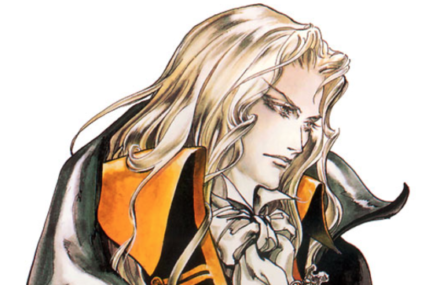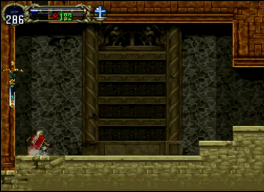The Complexities of Castlevania: SOTN – Traversal
December 1st, 2017
[When developing Castlevania: Symphony of the Night, director Koji Igarashi wanted to make a game which would “overturn player’s ideas about Castlevania, yet also feel like a Castlevania game”. In pursuing this vision, his team made SOTN’s game system much more complex, incorporating RPG systems and a wide variety of nuanced player actions. This series of articles will examine how these additions shape SOTN’s core gameplay of moving through space to dodge and attack enemies.]
When Igarashi’s team were drafting up Alucard’s (the player avatar) ability set, they drew upon the framework established over the course of earlier Castlevania titles. However, the developers also made some alterations and introduced new mechanics which give SOTN its own particular character. I’ve picked out a few details (both new inclusions and series staples) which speak to the way SOTN mechanics and mechanical properties shape the nature of traversal and movement.
- Alucard walks at a constant speed and doesn’t gain momentum, which is appropriate given his relative size within the environment. As such, the player has enough time to see and react to the obstructions as they come into view.
- The player can control the height of Alucard’s jump through the length of button press and so the input has a direct relationship to the on-screen output which allows for a more intuitive sense of control.
- Alucard falls reasonably quickly, and so like the NES Castlevania games the player has little leeway to adjust their jumps in mid-air. In this way, SOTN prompts players to mentally foresee their complete jump trajectory before moving off the ground. For a lack of better word, the players need to play with more intentionality. This is particularly true in boss encounters where bad jumps can punish the player.
- Player’s can upgrade to a double jump with the leap stone relic. The second jump height is shorter than the first. The reason being that fitting two differently shaped pieces together when planning your jumps is a much more interesting spatial challenge than combining two equal halves.
- The extra hop gives the player two levels of added control over the jump. They can choose when to do the second jump and how high to make it. These options facilitate various types of higher level manoeuvres such as floating, high jumping, and hopping. A good amount of gameplay potential can be extracted out of a reasonably simple addition.
- With two jumps, players can also react to any sudden changes in the environment when Alucard’s mid-flight. In this sense, only having the single jump available at the start of the game encourages the player to be more cautious and observe more of their surroundings. Some time later, once the player is more in tune with the dangers of Dracula’s castle, the game provides them the means of better navigating around these dangers.
- Alucard can high jump when the gravity boots relic is equipped. The inputs (press down and up on the d-pad and then jump) make the mechanic distinct from jump and double jump. However, the somewhat particular rules governing the mechanic’s execution (Alucard can perform a high jump when on the ground and after a double jump, but not after a regular jump), cloud the technique with some ambiguity. Also, the screen-high ceilings of Dracula’s castle limit the applications for a jump which stretches two and a half screens tall. The occasional hall or exterior setting provide opportunities for players to use the technique, but pepperings of enemies in these areas restrict these few potential spaces. Furthermore, the bat form allows Alucard to navigate vertical spaces with much more foresight than the high jump. So although the high jump looks flashy, it doesn’t offer much functionality.
- When in the air, Alucard can do an air kick, slicing straight down or diagonally. As with high jump, the particular nature of the mechanic limits its functionality. The player must double jump to perform the technique, which increases the complexity of envisioning the attack and its trajectory in the mind’s eye. In terms of traversal, the diagonal kicks make light work of staircases. Players can also exploit the technique’s rebound (which allows Alucard to enter into another kick) to skim across a series of light fightings or off the heads of a row of enemies. Although highly satisfying, such techniques are too nuanced and the applicable situations too few for the majority of players to incorporate into their repertoire.
- The back dash is a quick backwards retreat that acts as a dodge move. It’s also a viable, if not unorthodox alternative to walking (and by the looks of most SOTN speed runs, a faster method too). Alucard’s animation state suspends between rooms, making it possible to continuously moon walk your way through the castle.
Overall, we can see that the complexity added to Alucard’s repertoire of traversal mechanics both in terms of the number of mechanics and the complexity of each mechanic lead to more nuanced-driven gameplay. I would argue that very little of the nuance (probably only the extra hop in the double jump) has the ease of use and functional benefit to serve your average play in any meaningful way. (On the contrary, these nuances help buoy the SOTN speedrunning scene). The inclusion of these nuances as well as mechanics with particularly narrow functional purpose clutter SOTNs play experience with unviable options.






 Game Design Companion: A Critical Analysis of Wario Land 4 - $7.99
Game Design Companion: A Critical Analysis of Wario Land 4 - $7.99 Level Design: Processes and Experiences
Level Design: Processes and Experiences Speed Boost: The Hidden Secrets Behind Arcade Racing Design - $5.99
Speed Boost: The Hidden Secrets Behind Arcade Racing Design - $5.99 Adventures in Games Analysis: Volume I - $5.99
Adventures in Games Analysis: Volume I - $5.99







